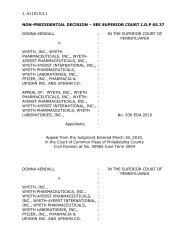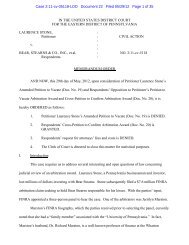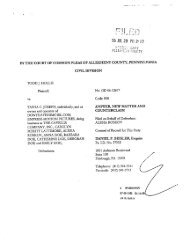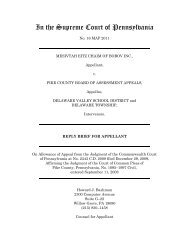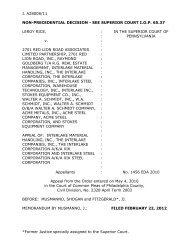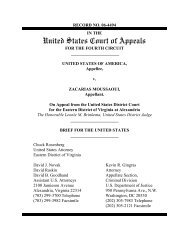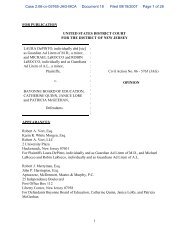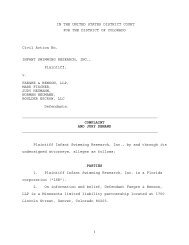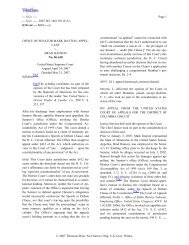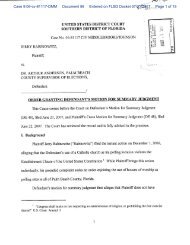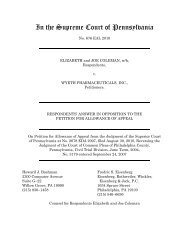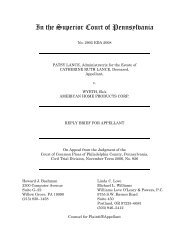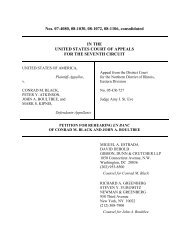the Brief in Opposition - How Appealing
the Brief in Opposition - How Appealing
the Brief in Opposition - How Appealing
Create successful ePaper yourself
Turn your PDF publications into a flip-book with our unique Google optimized e-Paper software.
In The Supreme Court of Pennsylvania<br />
Nos. 869 & 870 MAL 2007<br />
LAURA A. AMBROGI, Co–Adm<strong>in</strong>istrator of <strong>the</strong> Estate of Tara DeSimone; and<br />
JAMES M. HOBAN, Co–Adm<strong>in</strong>istrator of <strong>the</strong> Estate of Tara DeSimone; and<br />
FRANK C. CIFELLI, Co–Adm<strong>in</strong>istrator of <strong>the</strong> Estate of Joseph DeSimone, a M<strong>in</strong>or;<br />
and JAMES M. HOBAN, Co–Adm<strong>in</strong>istrator of <strong>the</strong> Estate of Joseph DeSimone,<br />
a M<strong>in</strong>or,<br />
Pla<strong>in</strong>tiffs/Respondents,<br />
v.<br />
ROBERT M. REBER; and ROSEMARY REBER; and REBER REAL ESTATE, INC.;<br />
And REBER PROPERTY MANAGEMENT; et al.,<br />
Defendants/Petitioners.<br />
BRIEF IN OPPOSITION TO<br />
PETITION FOR ALLOWANCE OF APPEAL<br />
On Petition for Allowance of Appeal from <strong>the</strong> Judgment of <strong>the</strong> Superior Court of<br />
Pennsylvania at Nos. 1700 &1840 EDA 2006 filed September 7, 2007, Affirm<strong>in</strong>g <strong>the</strong><br />
Prelim<strong>in</strong>ary Injunction of <strong>the</strong> Court of Common Pleas of Delaware County,<br />
No. 05–2118 entered June 20, 2006<br />
<strong>How</strong>ard J. Bashman<br />
2300 Computer Avenue<br />
Suite G–22<br />
Willow Grove, PA 19090<br />
(215) 830–1458<br />
Counsel for Pla<strong>in</strong>tiffs/Respondents<br />
Larry Bendesky<br />
Brian E. Fritz<br />
Carmen P. Belefonte<br />
Saltz, Mongeluzzi, Barrett &<br />
Bendesky, P.C.<br />
1650 Market Street, 52nd Floor<br />
Philadelphia, PA 19103<br />
(215) 496–8282
TABLE OF CONTENTS<br />
Page<br />
I. INTRODUCTION ............................................................................................... 1<br />
II. RELEVANT FACTUAL AND PROCEDURAL HISTORY................................ 3<br />
III. REASONS WHY THE PETITION FOR ALLOWANCE OF APPEAL<br />
SHOULD BE DENIED ....................................................................................... 9<br />
A. Defendants’ Contention That The Superior Court Should Have<br />
Adopted Federal Law Or The Supposed Law Of Seven O<strong>the</strong>r<br />
States In Decid<strong>in</strong>g Whe<strong>the</strong>r To Affirm The Prohibitory<br />
Prelim<strong>in</strong>ary Injunction Is Without Merit And Has Been Waived.......... 9<br />
B. The Pennsylvania Superior Court’s Rul<strong>in</strong>g Rests On Well–<br />
Settled Pr<strong>in</strong>ciples Of Pennsylvania Law That Have Been<br />
Employed Rarely, Selectively, And Only In The Most<br />
Exceptional Cases .................................................................................. 15<br />
C. The F<strong>in</strong>al Basis For Allowance Of Appeal Asks This Court To<br />
Review And Correct Factual And Discretionary Determ<strong>in</strong>ations<br />
Made By The Trial Court And Thus Fails To Satisfy Any Of This<br />
Court’s Rigorous Standards For Review ............................................... 17<br />
IV. CONCLUSION.................................................................................................. 23
Cases<br />
TABLE OF AUTHORITIES<br />
Page<br />
Commonwealth v. Piper, 458 Pa. 307, 328 A.2d 845 (1974)....................................... 12<br />
Grupo Mexicano de Desarrollo, S.A. v. Alliance Bond Fund, Inc.,<br />
527 U.S. 308 (1999) ....................................................................... 2, 9–11, 13, 14<br />
Hoxworth v. Bl<strong>in</strong>der, Rob<strong>in</strong>son & Co., 903 F.2d 186 (3d Cir. 1990).......................... 13<br />
Pentlong Corp. v. GLS Capital, Inc., 573 Pa. 34, 820 A.2d 1240 (2003).................... 12<br />
Scratch Golf Co. v. Dunes West Residential Golf Properties, Inc.,<br />
603 S.E.2d 905 (S.C. 2004) ............................................................................... 14<br />
Walter v. Stacy, 837 A.2d 1205 (Pa. Super. Ct. 2003) ...................................... 7, 15, 16<br />
Statutes<br />
12 Pa. Cons. Stat. Ann. §§5101–5110 ......................................................................... 16<br />
12 Pa. Cons. Stat. Ann. §5101..................................................................................... 17<br />
12 Pa. Cons. Stat. Ann. §5104(a)(1) ............................................................................ 16<br />
12 Pa. Cons. Stat. Ann. §5107(a)(3)(i)......................................................................... 17<br />
Court Rules<br />
Pa. R. App. P. 302(a).................................................................................................... 12<br />
Pa. R. App. P. 1925(a).............................................................................................. 4, 18<br />
– ii –
I. INTRODUCTION<br />
On December 8, 2003, 23–year–old Tara DeSimone and her four–year–old<br />
son Joseph burned to death <strong>in</strong> a fire that occurred <strong>in</strong> <strong>the</strong> apartment where <strong>the</strong>y<br />
resided at 338 Beverly Boulevard <strong>in</strong> Upper Darby, Pennsylvania. The boy’s fa<strong>the</strong>r,<br />
Frank Cifelli, also lived <strong>in</strong> <strong>the</strong> apartment, and he suffered severe <strong>in</strong>juries <strong>in</strong> <strong>the</strong> fire<br />
but survived.<br />
In this lawsuit, <strong>the</strong> estates of Tara and Joseph DeSimone toge<strong>the</strong>r with<br />
Frank Cifelli have asserted that <strong>the</strong> owners of <strong>the</strong>ir apartment — defendants<br />
Robert and Rosemary Reber, ei<strong>the</strong>r <strong>in</strong>dividually or through Reber Real Estate, Inc.<br />
and/or Reber Property Management — are responsible <strong>in</strong> tort for hav<strong>in</strong>g caused <strong>the</strong><br />
deaths of Tara and Joseph DeSimone and <strong>the</strong> serious <strong>in</strong>juries susta<strong>in</strong>ed by Cifelli.<br />
The Reber defendants possess only $1 million <strong>in</strong> liability <strong>in</strong>surance applicable<br />
to <strong>the</strong> pla<strong>in</strong>tiffs’ claims. Between <strong>the</strong> time of <strong>the</strong> deadly fire and pla<strong>in</strong>tiffs’ motion<br />
for a prelim<strong>in</strong>ary <strong>in</strong>junction, <strong>the</strong> Reber defendants had sold off more than $3 million<br />
<strong>in</strong> real estate hold<strong>in</strong>gs, <strong>the</strong> proceeds of which were not re<strong>in</strong>vested back <strong>in</strong>to <strong>the</strong>ir<br />
real estate bus<strong>in</strong>ess enterprise. After conduct<strong>in</strong>g two evidentiary hear<strong>in</strong>gs and<br />
f<strong>in</strong>d<strong>in</strong>g that <strong>the</strong> Reber defendants appeared to be engaged <strong>in</strong> a process of render<strong>in</strong>g<br />
<strong>the</strong>mselves judgment–proof from execution on <strong>the</strong> excess judgment that appears<br />
certa<strong>in</strong> to result from pla<strong>in</strong>tiffs’ lawsuit, Judge Charles B. Burr, II of <strong>the</strong> Court of<br />
Common Pleas of Delaware County issued a limited and f<strong>in</strong>ely–calibrated<br />
prelim<strong>in</strong>ary <strong>in</strong>junction that merely requires <strong>the</strong> Reber defendants go<strong>in</strong>g forward to<br />
deposit <strong>the</strong> net proceeds realized on <strong>the</strong> sale of real estate properties <strong>in</strong>to a court–
monitored escrow account. The defendants are free to use or re<strong>in</strong>vest <strong>the</strong> money <strong>in</strong><br />
that escrow account on application to <strong>the</strong> trial court. The Superior Court’s<br />
affirmance of <strong>the</strong> trial court’s prelim<strong>in</strong>ary <strong>in</strong>junction absolutely does not preclude<br />
<strong>the</strong> defendants’ cont<strong>in</strong>ued use <strong>in</strong> <strong>the</strong> normal course of bus<strong>in</strong>ess of proceeds from<br />
sales of <strong>the</strong>ir real estate hold<strong>in</strong>gs.<br />
The prelim<strong>in</strong>ary <strong>in</strong>junction that <strong>the</strong> Reber defendants challenge by means of<br />
<strong>the</strong>ir Petition for Allowance of Appeal is based on well–settled Pennsylvania law,<br />
represents a proper exercise of <strong>the</strong> trial court’s discretion, and will <strong>in</strong> reality be<br />
mooted by <strong>the</strong> result of <strong>the</strong> jury trial scheduled to beg<strong>in</strong> <strong>in</strong> this case on March 17,<br />
2008. Moreover, <strong>the</strong> ma<strong>in</strong> argument advanced <strong>in</strong> <strong>the</strong> Petition for Allowance of<br />
Appeal — that <strong>the</strong> trial court’s <strong>in</strong>junction is contrary to <strong>in</strong>applicable federal law<br />
announced <strong>in</strong> <strong>the</strong> U.S. Supreme Court’s 5–4 rul<strong>in</strong>g <strong>in</strong> Grupo Mexicano de<br />
Desarrollo, S.A. v. Alliance Bond Fund, Inc., 527 U.S. 308 (1999) — is waived<br />
because <strong>the</strong> Reber defendants failed to cite to Grupo Mexicano <strong>in</strong> <strong>the</strong>ir Pa. Superior<br />
Court brief<strong>in</strong>g. Nor did <strong>the</strong> Reber defendants call <strong>the</strong> Grupo Mexicano decision to<br />
<strong>the</strong> Pa. Superior Court’s attention <strong>in</strong> any o<strong>the</strong>r manner, and <strong>the</strong> Reber defendants<br />
likewise never once cited to Grupo Mexicano while <strong>the</strong> pla<strong>in</strong>tiffs’ prelim<strong>in</strong>ary<br />
<strong>in</strong>junction request was pend<strong>in</strong>g before <strong>the</strong> trial court.<br />
For <strong>the</strong>se reasons, and <strong>the</strong> additional reasons detailed below, <strong>the</strong> Petition for<br />
Allowance of Appeal should be denied.<br />
– 2 –
II. RELEVANT FACTUAL AND PROCEDURAL HISTORY<br />
The lawsuit that gives rise to this matter asserts that <strong>the</strong> Reber defendants<br />
are liable <strong>in</strong> tort for hav<strong>in</strong>g caused <strong>the</strong> deaths of 23–year–old Tara DeSimone and<br />
her four–year–old son Joseph, both of whom burned to death <strong>in</strong> a fire that occurred<br />
<strong>in</strong> an apartment owned and ma<strong>in</strong>ta<strong>in</strong>ed by <strong>the</strong> Reber defendants. The lawsuit also<br />
asserts that <strong>the</strong> Reber defendants are liable <strong>in</strong> tort for hav<strong>in</strong>g caused pla<strong>in</strong>tiff<br />
Frank Cifelli, who was Joseph’s fa<strong>the</strong>r and Tara’s companion, to susta<strong>in</strong> serious<br />
<strong>in</strong>juries <strong>in</strong> that very same fire. The fire occurred on December 8, 2003 at 338<br />
Beverly Boulevard <strong>in</strong> Upper Darby, Pennsylvania.<br />
In May 2006, <strong>the</strong> Reber defendants notified counsel for <strong>the</strong> pla<strong>in</strong>tiffs that <strong>the</strong><br />
338 Beverly Boulevard property was under contract to be sold to an unrelated<br />
third–party. Shortly <strong>the</strong>reafter, <strong>the</strong> pla<strong>in</strong>tiffs discovered that <strong>the</strong> Reber defendants<br />
had, between <strong>the</strong> time of <strong>the</strong> fire <strong>in</strong> December 2003 and May 2006, sold off more<br />
than $3 million <strong>in</strong> real estate hold<strong>in</strong>gs without re<strong>in</strong>vest<strong>in</strong>g any of <strong>the</strong> proceeds of<br />
those sales back <strong>in</strong>to <strong>the</strong>ir real estate bus<strong>in</strong>ess.<br />
It is undisputed that <strong>the</strong> Reber defendants possess only $1 million <strong>in</strong> liability<br />
<strong>in</strong>surance applicable to pla<strong>in</strong>tiffs’ claims — that defendants are liable <strong>in</strong> tort for<br />
caus<strong>in</strong>g <strong>the</strong> death of a young mo<strong>the</strong>r and her small child and caus<strong>in</strong>g serious<br />
personal <strong>in</strong>juries to a third person, stemm<strong>in</strong>g from a fire alleged to have resulted<br />
from defendants’ negligence. It is also undisputed that <strong>the</strong> value of pla<strong>in</strong>tiffs’ claims<br />
aga<strong>in</strong>st <strong>the</strong> Reber defendants is substantially <strong>in</strong> excess of $1 million.<br />
– 3 –
Believ<strong>in</strong>g that <strong>the</strong> Reber defendants were engaged <strong>in</strong> an ongo<strong>in</strong>g scheme<br />
<strong>in</strong>tended to divest <strong>the</strong>mselves of assets to make <strong>the</strong>mselves execution–proof <strong>in</strong> <strong>the</strong><br />
event of a verdict <strong>in</strong> favor of <strong>the</strong> pla<strong>in</strong>tiffs <strong>in</strong> excess of <strong>the</strong> $1 million <strong>in</strong>surance<br />
coverage applicable to <strong>the</strong> deadly fire, pla<strong>in</strong>tiffs moved for a prelim<strong>in</strong>ary <strong>in</strong>junction<br />
to require only that <strong>the</strong> Reber defendants place <strong>in</strong>to a court–supervised escrow<br />
account <strong>the</strong> net proceeds of any sale of real property, which could <strong>the</strong>n be re<strong>in</strong>vested<br />
by <strong>the</strong> Reber defendants at any time with approval of <strong>the</strong> trial court.<br />
After two separate lengthy hear<strong>in</strong>gs, <strong>the</strong> Court of Common Pleas of Delaware<br />
County issued a limited and f<strong>in</strong>ely–calibrated prelim<strong>in</strong>ary <strong>in</strong>junction that merely<br />
requires <strong>the</strong> defendant to deposit <strong>in</strong>to a court–supervised escrow account <strong>the</strong> net<br />
proceeds of future real estate sales, which may be used or o<strong>the</strong>rwise re<strong>in</strong>vested on<br />
application to <strong>the</strong> trial court.<br />
As Judge Burr expla<strong>in</strong>s <strong>in</strong> his Rule 1925(a) op<strong>in</strong>ion:<br />
Trial court op<strong>in</strong>ion at 19.<br />
states:<br />
The amount of a potential verdict aga<strong>in</strong>st <strong>the</strong> Defendants <strong>in</strong> <strong>the</strong> case at<br />
bar cannot be presently ascerta<strong>in</strong>ed, and given <strong>the</strong> horrific deaths and<br />
<strong>in</strong>juries from <strong>the</strong> fire that gave rise to this law suit, <strong>the</strong> damages<br />
awarded, if Pla<strong>in</strong>tiffs prevail, could be large <strong>in</strong>deed. To allow <strong>the</strong><br />
Defendants <strong>the</strong> ability to spend <strong>the</strong> proceeds of liquidation of <strong>the</strong>ir<br />
assets at will under <strong>the</strong> circumstances before <strong>the</strong> Court will thus work<br />
an irreparable harm to <strong>the</strong> pla<strong>in</strong>tiffs’ ability to recover <strong>the</strong> full<br />
measure of <strong>the</strong> damages <strong>in</strong>curred.<br />
In sett<strong>in</strong>g forth <strong>the</strong> basis for <strong>the</strong> prelim<strong>in</strong>ary <strong>in</strong>junction, Judge Burr’s op<strong>in</strong>ion<br />
Although Defendants have realized close to $3,000,000.00 from this<br />
apparent fire sale of <strong>the</strong>ir property s<strong>in</strong>ce December of 2003, <strong>the</strong>re is no<br />
evidence that <strong>the</strong>y are still <strong>in</strong> possession of <strong>the</strong>se funds or whe<strong>the</strong>r, as<br />
– 4 –
Id. at 17<br />
defense counsel have occasionally and jok<strong>in</strong>gly suggested, <strong>the</strong>y were<br />
used to buy a boat or were given to o<strong>the</strong>rs, or are sitt<strong>in</strong>g <strong>in</strong> a bank <strong>in</strong><br />
<strong>the</strong> Cayman Islands. All <strong>in</strong> all, <strong>the</strong> rapid rate of <strong>the</strong> tim<strong>in</strong>g and <strong>the</strong><br />
large amount of proceeds realized from Defendants’ sale of <strong>the</strong>ir assets<br />
s<strong>in</strong>ce <strong>the</strong> time of <strong>the</strong> fire, coupled with <strong>the</strong> potential for a verdict larger<br />
than <strong>the</strong> available <strong>in</strong>surance coverage, as well as <strong>the</strong> case authority of<br />
Walter v. Stacy, supra, which is relevant to just such circumstances as<br />
are presented here below, provide a reasonable basis for entry of <strong>the</strong><br />
unobtrusive and well–tailored Order which is <strong>the</strong> subject of this<br />
appeal.<br />
In a critical passage that <strong>the</strong> Petition for Allowance of Appeal essentially<br />
overlooks, Judge Burr’s op<strong>in</strong>ion <strong>the</strong>n proceeds to expla<strong>in</strong>:<br />
Id.<br />
Fur<strong>the</strong>r, this Order does not preclude nor impede <strong>the</strong> Defendants from<br />
enter<strong>in</strong>g <strong>in</strong>to any real estate purchase or sale, nor does it cloud title to<br />
any of <strong>the</strong> properties that might be <strong>in</strong>volved, nor encumber any sale as<br />
claimed. The Order merely requires <strong>the</strong> Defendants to advise <strong>the</strong> Court<br />
of any sale or transfer of any real property <strong>in</strong> which <strong>the</strong>y possess an<br />
ownership <strong>in</strong>terest, to place <strong>the</strong> net proceeds <strong>the</strong>reof <strong>in</strong> an <strong>in</strong>terest<br />
bear<strong>in</strong>g account <strong>in</strong> accord with Defendants’ own suggestion, and to<br />
petition <strong>the</strong> Court for permission to make withdrawals <strong>the</strong>refrom.<br />
In <strong>the</strong> nearly one and a half years s<strong>in</strong>ce <strong>the</strong> trial court entered that<br />
prelim<strong>in</strong>ary <strong>in</strong>junction, <strong>the</strong> trial court has not once prevented <strong>the</strong> Reber defendants<br />
from re<strong>in</strong>vest<strong>in</strong>g <strong>the</strong> proceeds of sales of real estate back <strong>in</strong>to <strong>the</strong>ir real estate<br />
bus<strong>in</strong>ess. Quite simply, <strong>the</strong> prelim<strong>in</strong>ary <strong>in</strong>junction only prevents <strong>the</strong> Reber<br />
defendants from abscond<strong>in</strong>g away with <strong>the</strong> assets of <strong>the</strong>ir bus<strong>in</strong>ess enterprises so as<br />
to make <strong>the</strong>mselves judgment–proof <strong>in</strong> <strong>the</strong> event of a judgment <strong>in</strong> excess of one<br />
million dollars.<br />
– 5 –
The Reber defendants <strong>the</strong>reafter appealed from <strong>the</strong> entry of <strong>the</strong> prelim<strong>in</strong>ary<br />
<strong>in</strong>junction to <strong>the</strong> Superior Court of Pennsylvania. On appeal, <strong>the</strong> Reber defendants<br />
did not argue — as <strong>the</strong>y now ma<strong>in</strong>ta<strong>in</strong> as <strong>the</strong> central basis of <strong>the</strong>ir Petition for<br />
Allowance of Appeal — that a prelim<strong>in</strong>ary <strong>in</strong>junction entered to preserve a<br />
defendant’s assets where <strong>the</strong> evidence strongly suggests <strong>the</strong> pursuit of a scheme to<br />
become judgment–proof is never lawfully permitted. Ra<strong>the</strong>r, <strong>in</strong> <strong>the</strong> Superior Court,<br />
<strong>the</strong> Reber defendants had only argued that <strong>the</strong> trial court abused its discretion by<br />
supposedly misweigh<strong>in</strong>g <strong>the</strong> handful of factors pert<strong>in</strong>ent to <strong>the</strong> grant of a<br />
prelim<strong>in</strong>ary <strong>in</strong>junction.<br />
On April 10, 2007, <strong>the</strong>re was oral argument <strong>in</strong> this appeal before a panel<br />
consist<strong>in</strong>g of three of <strong>the</strong> Pa. Superior Court’s most experienced jurists: Joseph A.<br />
Hudock, Maureen Lally–Green, and Robert E. Colville. On July 24, 2007, that<br />
three–judge panel issued a non–precedential Memorandum Op<strong>in</strong>ion affirm<strong>in</strong>g <strong>the</strong><br />
trial court’s prelim<strong>in</strong>ary <strong>in</strong>junction. The use of a non–precedential Memorandum<br />
Op<strong>in</strong>ion reflected <strong>the</strong> Superior Court panel’s considered judgment that its rul<strong>in</strong>g<br />
consisted of an uncontroversial application of well–settled exist<strong>in</strong>g law.<br />
On petition of <strong>the</strong> pla<strong>in</strong>tiffs, which <strong>the</strong> Reber defendants opposed, <strong>the</strong><br />
Superior Court panel decided to withdraw <strong>the</strong> Memorandum Op<strong>in</strong>ion and reissue<br />
<strong>the</strong> identical decision as a published op<strong>in</strong>ion <strong>in</strong> which Judge Hudock was identified<br />
as <strong>the</strong> author. It is from that decision that <strong>the</strong> Reber defendants have filed <strong>the</strong>ir<br />
Petition for Allowance of Appeal.<br />
– 6 –
Judge Hudock’s op<strong>in</strong>ion for <strong>the</strong> Superior Court expla<strong>in</strong>s that “[t]he entry of a<br />
prelim<strong>in</strong>ary <strong>in</strong>junction for <strong>the</strong> purpose of enjo<strong>in</strong><strong>in</strong>g <strong>the</strong> dissipation of assets <strong>in</strong><br />
anticipation of a lawsuit is not a novel event.” Slip Op. at 8. Rely<strong>in</strong>g primarily on<br />
<strong>the</strong> Pa. Superior Court’s 2003 precedent <strong>in</strong> Walter v. Stacy, 837 A.2d 1205 (Pa.<br />
Super. Ct. 2003), Judge Hudock’s op<strong>in</strong>ion expla<strong>in</strong>s: “There is noth<strong>in</strong>g unique about<br />
<strong>the</strong> requirement imposed by <strong>the</strong> trial court <strong>in</strong> this case that precludes Appellants<br />
from sell<strong>in</strong>g <strong>the</strong>ir real property without plac<strong>in</strong>g <strong>the</strong> net proceeds <strong>in</strong>to a court<br />
supervised escrow account. * * * We conclude that Pennsylvania law does not<br />
preclude a trial court from grant<strong>in</strong>g a prelim<strong>in</strong>ary <strong>in</strong>junction to prevent dissipation<br />
of assets.” Slip Op. at 9.<br />
Judge Hudock’s op<strong>in</strong>ion conta<strong>in</strong>s <strong>the</strong> follow<strong>in</strong>g summary of <strong>the</strong> trial court’s<br />
f<strong>in</strong>d<strong>in</strong>gs <strong>in</strong> support of <strong>the</strong> prelim<strong>in</strong>ary <strong>in</strong>junction:<br />
Slip Op. at 12.<br />
The trial court has expla<strong>in</strong>ed <strong>in</strong> great detail why it concluded<br />
that an <strong>in</strong>junction was necessary to prevent immediate and irreparable<br />
harm to Appellees that cannot o<strong>the</strong>rwise be compensated adequately.<br />
The trial court found <strong>the</strong> likelihood to be “undeniably strong” that a<br />
jury will return a verdict well <strong>in</strong> excess of a million dollars <strong>in</strong> this case.<br />
Trial Court Op<strong>in</strong>ion, 11/9/06, at 16. <strong>How</strong>ever, <strong>the</strong> record discloses that<br />
Appellants have only a million dollars <strong>in</strong> liability <strong>in</strong>surance applicable<br />
to <strong>the</strong> fire that caused <strong>the</strong> deaths by burn<strong>in</strong>g of a young mo<strong>the</strong>r and<br />
her child and <strong>the</strong> serious <strong>in</strong>jury of a third <strong>in</strong>dividual. Id. Appellants do<br />
possess extensive real estate hold<strong>in</strong>gs <strong>in</strong> Pennsylvania, which <strong>the</strong> trial<br />
court found would be more than adequate to satisfy any verdict<br />
Appellees are likely to obta<strong>in</strong> aga<strong>in</strong>st Appellants—but only if<br />
Appellants rema<strong>in</strong> <strong>in</strong> possession of <strong>the</strong>se assets at <strong>the</strong> time a judgment<br />
is entered. Id. at 16–17.<br />
– 7 –
In affirm<strong>in</strong>g <strong>the</strong> prelim<strong>in</strong>ary <strong>in</strong>junction at issue, <strong>the</strong> Superior Court took care<br />
to emphasize <strong>the</strong> prelim<strong>in</strong>ary <strong>in</strong>junction’s limited and f<strong>in</strong>ely–calibrated effect,<br />
which <strong>the</strong> Reber defendants ignore <strong>in</strong> <strong>the</strong>ir Petition for Allowance of Appeal:<br />
Appellants have not been precluded from list<strong>in</strong>g and sell<strong>in</strong>g<br />
<strong>the</strong>ir properties, from re<strong>in</strong>vest<strong>in</strong>g <strong>the</strong> net proceeds from any sales or<br />
from us<strong>in</strong>g <strong>the</strong> net proceeds <strong>in</strong> a manner consistent with <strong>the</strong>ir normal<br />
bus<strong>in</strong>ess practices. The trial court’s <strong>in</strong>junction simply prevents<br />
Appellants from liquidat<strong>in</strong>g <strong>the</strong>ir properties for <strong>the</strong> purpose of hid<strong>in</strong>g<br />
or dissipat<strong>in</strong>g assets. As already discussed, Appellees have been<br />
required to post a bond sufficient to cover any loss of <strong>in</strong>terest<br />
Appellants might experience by be<strong>in</strong>g required to escrow funds. We<br />
aga<strong>in</strong> note that <strong>the</strong> trial court clearly <strong>in</strong>dicated it would establish a<br />
reasonable ceil<strong>in</strong>g to <strong>the</strong> amount held <strong>in</strong> escrow and that Appellants<br />
are free to petition at any time for <strong>the</strong> release of funds so that <strong>the</strong>ir<br />
assets can be used to run <strong>the</strong>ir bus<strong>in</strong>ess and are not irrationally tied–<br />
up.<br />
Id. at 18–19 (citations omitted).<br />
As Judge Hudock’s op<strong>in</strong>ion recognizes, “Appellants have not cited to any<br />
authority, ei<strong>the</strong>r statutory or decisional, that affords <strong>the</strong>m a legal right to dissipate<br />
assets for <strong>the</strong> purpose of becom<strong>in</strong>g judgment–proof. This is <strong>the</strong> conduct that <strong>the</strong><br />
trial court’s <strong>in</strong>junction prohibits, not <strong>the</strong> lawful conduct of runn<strong>in</strong>g <strong>the</strong>ir bus<strong>in</strong>ess.”<br />
Slip Op. at 19.<br />
Judge Hudock, writ<strong>in</strong>g on behalf of a unanimous three–judge Pa. Superior<br />
Court panel, is absolutely correct. The Reber defendants’ Petition for Allowance of<br />
Appeal brazenly asks this Court to grant allocatur to hold that Pennsylvania law<br />
would permit defendants whose negligence has caused a young mo<strong>the</strong>r and her<br />
four–year–old child to burn to death and <strong>the</strong> child’s fa<strong>the</strong>r to suffer severe <strong>in</strong>juries<br />
– 8 –
<strong>in</strong> that same fire to systematically render <strong>the</strong>mselves judgment–proof <strong>in</strong> order to<br />
avoid f<strong>in</strong>ancial responsibility for <strong>the</strong>ir tortious misconduct.<br />
Such an outrageous request should not be granted by this Honorable Court.<br />
Fortunately, <strong>the</strong> Petition for Allowance of Appeal fails to establish that any of <strong>the</strong><br />
three <strong>the</strong> questions presented <strong>the</strong>re<strong>in</strong> are worthy of this Court’s review, and<br />
<strong>the</strong>refore <strong>the</strong> Petition for Allowance of Appeal should be denied.<br />
III. REASONS WHY THE PETITION FOR ALLOWANCE OF APPEAL<br />
SHOULD BE DENIED<br />
A. Defendants’ Contention That The Superior Court Should Have<br />
Adopted Federal Law Or The Supposed Law Of Seven O<strong>the</strong>r<br />
States In Decid<strong>in</strong>g Whe<strong>the</strong>r To Affirm The Prohibitory<br />
Prelim<strong>in</strong>ary Injunction Is Without Merit And Has Been Waived<br />
This case <strong>in</strong>volves absolutely no federal question whatsoever that might<br />
arguably cause <strong>the</strong> U.S. Supreme Court rul<strong>in</strong>g on which <strong>the</strong> Petition for Allowance<br />
of Appeal relies so heavily to be relevant to this case.<br />
Due to a unique quirk of federal law, <strong>the</strong> equitable power of U.S. District<br />
Courts is limited to <strong>the</strong> power that chancery courts possessed <strong>in</strong> England <strong>in</strong> <strong>the</strong><br />
year 1789. Thus, <strong>the</strong> question confront<strong>in</strong>g <strong>the</strong> U.S. Supreme Court <strong>in</strong> Grupo<br />
Mexicano de Desarrollo, S.A. v. Alliance Bond Fund, Inc., 527 U.S. 308 (1999), was<br />
whe<strong>the</strong>r a prelim<strong>in</strong>ary <strong>in</strong>junction could be used to restra<strong>in</strong> a defendant’s assets to<br />
protect a potential money judgment <strong>in</strong> favor of <strong>the</strong> pla<strong>in</strong>tiff under federal common<br />
law applicable only <strong>in</strong> <strong>the</strong> federal court system.<br />
– 9 –
Recogniz<strong>in</strong>g that Congress could legislate such a remedy, <strong>the</strong> majority <strong>in</strong> <strong>the</strong><br />
U.S. Supreme Court’s 5–4 rul<strong>in</strong>g <strong>in</strong> Grupo Mexicano held that because <strong>the</strong> chancery<br />
courts of England did not recognize <strong>the</strong> propriety of such an <strong>in</strong>junction <strong>in</strong> 1789,<br />
federal district courts lacked <strong>the</strong> power under federal common law to issue such an<br />
<strong>in</strong>junction today. Both <strong>the</strong> majority and dissent <strong>in</strong> <strong>the</strong> Grupo Mexicano case<br />
recognized that <strong>in</strong> 1975, England’s chancery courts issued a rul<strong>in</strong>g that recognized<br />
as proper and lawful <strong>the</strong> use of a prelim<strong>in</strong>ary <strong>in</strong>junction to restra<strong>in</strong> a defendant’s<br />
assets to protect a potential money judgment <strong>in</strong> favor of <strong>the</strong> pla<strong>in</strong>tiff. See Grupo<br />
Mexicano, 527 U.S. at 327 (not<strong>in</strong>g that <strong>the</strong> English Court of Chancery “did not<br />
provide an <strong>in</strong>junctive remedy such as this until 1975”); id. at 339 (G<strong>in</strong>sburg, J.,<br />
dissent<strong>in</strong>g) (“As <strong>the</strong> Court observes, prelim<strong>in</strong>ary asset–freeze <strong>in</strong>junctions have been<br />
available <strong>in</strong> English courts s<strong>in</strong>ce * * * 1975”). But because English equitable courts<br />
had not recognized <strong>the</strong> remedy <strong>in</strong> 1789, <strong>the</strong> majority <strong>in</strong> Grupo Mexicano, by a<br />
sharply divided 5–4 vote, ruled that later developments <strong>in</strong> <strong>the</strong> equitable law of<br />
England were irrelevant to <strong>the</strong> equitable authority of federal district courts <strong>in</strong> <strong>the</strong><br />
United States. It bears observation that two members of <strong>the</strong> slender five Justice<br />
majority <strong>in</strong> Grupo Mexicano — Chief Justice William H. Rehnquist and Associate<br />
Justice Sandra Day O’Connor — have s<strong>in</strong>ce left <strong>the</strong> Court.<br />
The Petition for Allowance of Appeal relies on <strong>the</strong> U.S. Supreme Court’s 1999<br />
rul<strong>in</strong>g <strong>in</strong> Grupo Mexicano and <strong>the</strong> decisions of <strong>the</strong> courts of seven o<strong>the</strong>r states (five<br />
of which were not issued by state courts of last resort) to assert that somehow <strong>the</strong><br />
Superior Court of Pennsylvania’s rul<strong>in</strong>g, which followed well–settled Pennsylvania<br />
– 10 –
law to prevent <strong>the</strong> Reber defendants from cont<strong>in</strong>u<strong>in</strong>g with <strong>the</strong>ir scheme to strip<br />
<strong>the</strong>mselves of all assets and thus become judgment–proof, is deserv<strong>in</strong>g of this<br />
Court’s review.<br />
This first ground for review advanced <strong>in</strong> <strong>the</strong> Reber defendants’ Petition for<br />
Allowance of Appeal must be rejected for two <strong>in</strong>dependent reasons: first, this<br />
ground for review has been waived, because <strong>the</strong> Reber defendants never once raised<br />
or relied on Grupo Mexicano or <strong>the</strong> o<strong>the</strong>r state court rul<strong>in</strong>gs <strong>in</strong> <strong>the</strong>ir appellate<br />
brief<strong>in</strong>g before <strong>the</strong> Pa. Superior Court; and second, <strong>the</strong> fact that seven state courts<br />
(<strong>in</strong> decisions whose authority is open to substantial question, as discussed below)<br />
have followed <strong>the</strong> U.S. Supreme Court’s antiquated view of equitable power does not<br />
make that outdated approach <strong>the</strong> “majority approach” or an approach that<br />
Pennsylvania courts should choose to follow.<br />
On <strong>the</strong> issue of waiver, <strong>the</strong> Reber defendants’ <strong>Brief</strong> for Appellants filed <strong>in</strong> <strong>the</strong><br />
Pa. Superior Court failed to cite even once to <strong>the</strong> U.S. Supreme Court’s rul<strong>in</strong>g <strong>in</strong><br />
Grupo Mexicano, and <strong>the</strong> <strong>Brief</strong> for Appellants never asserted that it was beyond a<br />
Pennsylvania court’s equitable authority to issue a prelim<strong>in</strong>ary <strong>in</strong>junction to<br />
restra<strong>in</strong> a defendant’s assets to protect a potential money judgment <strong>in</strong> favor of <strong>the</strong><br />
pla<strong>in</strong>tiff. The Reber defendants also failed to draw <strong>the</strong> Grupo Mexicano decision to<br />
<strong>the</strong> Pa. Superior Court’s attention <strong>in</strong> any o<strong>the</strong>r way and did not once mention <strong>the</strong><br />
rul<strong>in</strong>g at oral argument. Moreover, nei<strong>the</strong>r with<strong>in</strong> <strong>the</strong>ir brief nor at oral argument<br />
did <strong>the</strong> Reber defendants cite any of <strong>the</strong> o<strong>the</strong>r seven state court rul<strong>in</strong>gs that<br />
supposedly represent a “majority” view.<br />
– 11 –
Defendants ma<strong>in</strong>ta<strong>in</strong> <strong>in</strong> <strong>the</strong>ir Petition for Allowance of Appeal that <strong>the</strong> Pa.<br />
Superior Court’s earlier precedents did not compel a rul<strong>in</strong>g <strong>in</strong> favor of <strong>the</strong> pla<strong>in</strong>tiffs<br />
on appeal, but <strong>the</strong> defendants failed to present to <strong>the</strong> Superior Court any of <strong>the</strong> case<br />
law from o<strong>the</strong>r jurisdictions that defendants now contend <strong>the</strong> Superior Court erred<br />
<strong>in</strong> fail<strong>in</strong>g to follow. The defendants’ failure to draw that case law to <strong>the</strong> attention of<br />
<strong>the</strong> Superior Court gives rise to a classic <strong>in</strong>stance of waiver that mandates denial of<br />
<strong>the</strong> first question presented for review. See Pa. R. App. P. 302(a); Pentlong Corp. v.<br />
GLS Capital, Inc., 573 Pa. 34, 48 n.17, 820 A.2d 1240, 1248 n.17 (2003) (hold<strong>in</strong>g<br />
that argument not presented to <strong>in</strong>termediate appellate court is waived and will not<br />
be considered by this Court); Commonwealth v. Piper, 458 Pa. 307, 309–11, 328<br />
A.2d 845, 847 (1974) (issue not raised <strong>in</strong> trial court or Superior Court cannot be<br />
raised for first time on allocatur).<br />
Fur<strong>the</strong>rmore, <strong>the</strong> strength of authority that those seven state court rul<strong>in</strong>gs<br />
represent is vastly overstated <strong>in</strong> <strong>the</strong> Petition for Allowance of Appeal. Only two of<br />
those seven decisions come from state courts of last resort. Four of those seven<br />
decisions come from state <strong>in</strong>termediate appellate courts, two of those four are<br />
<strong>in</strong>termediate appellate courts lack<strong>in</strong>g statewide jurisdiction, and one of those four<br />
decisions is an unpublished, non–precedential <strong>in</strong>termediate appellate court rul<strong>in</strong>g.<br />
The f<strong>in</strong>al one of those seven state court rul<strong>in</strong>gs is a trial court’s op<strong>in</strong>ion. In short,<br />
defendants’ claim that those seven state court decisions represent a majority view is<br />
refuted by <strong>the</strong> very tenuous authority offered <strong>in</strong> support of that unconv<strong>in</strong>c<strong>in</strong>g claim.<br />
– 12 –
The Reber defendants’ Petition for Allowance of Appeal attempts to mislead<br />
this Court <strong>in</strong>to believ<strong>in</strong>g that perhaps <strong>the</strong> Reber defendants had presented this very<br />
same argument to <strong>the</strong> Pa. Superior Court, because <strong>the</strong> Petition for Allowance of<br />
Appeal chides <strong>the</strong> Superior Court for “ignor<strong>in</strong>g <strong>the</strong> substantial authority” consist<strong>in</strong>g<br />
of Grupo Mexicano and <strong>the</strong> aforementioned seven state court rul<strong>in</strong>gs. Pet. at 15. Yet<br />
it is <strong>the</strong> Reber defendants, and not <strong>the</strong> Pa. Superior Court, who must be faulted,<br />
because <strong>the</strong> Reber defendants did not cite to any of that case law when brief<strong>in</strong>g or<br />
argu<strong>in</strong>g this appeal before <strong>the</strong> Superior Court. The “substantial authority” that <strong>the</strong><br />
Reber defendants now condemn <strong>the</strong> Pa. Superior Court for “ignor<strong>in</strong>g” (Pet. at 15) is<br />
<strong>the</strong> very same “substantial authority” that <strong>the</strong> Reber defendants <strong>the</strong>mselves ignored<br />
<strong>in</strong> <strong>the</strong>ir <strong>Brief</strong> for Appellants filed <strong>in</strong> <strong>the</strong> Pa. Superior Court.<br />
To summarize, <strong>the</strong> Reber defendants’ argument before <strong>the</strong> Pa. Superior Court<br />
was never that a court of equity <strong>in</strong> Pennsylvania lacks <strong>the</strong> <strong>in</strong>herent power to issue<br />
<strong>the</strong> sort of prelim<strong>in</strong>ary <strong>in</strong>junction at issue here, and <strong>the</strong> only federal case that <strong>the</strong>y<br />
cited on that po<strong>in</strong>t recognized that even a federal court could issue such an<br />
<strong>in</strong>junction under appropriate circumstances, see Hoxworth v. Bl<strong>in</strong>der, Rob<strong>in</strong>son &<br />
Co., 903 F.2d 186, 198 (3d Cir. 1990) (Becker, J.). Even if <strong>the</strong> Pa. Superior Court’s<br />
rul<strong>in</strong>g aga<strong>in</strong>st <strong>the</strong> Reber defendants were erroneous, which it is not, it would consist<br />
of <strong>in</strong>vited error that <strong>the</strong> Reber defendants brought upon <strong>the</strong>mselves. Because <strong>the</strong><br />
first issue is waived, it provides no basis for grant<strong>in</strong>g allowance of appeal.<br />
Moreover, even if <strong>the</strong> Reber defendants’ argument based on Grupo Mexicano<br />
were not waived, it would still be without merit. The Supreme Court of South<br />
– 13 –
Carol<strong>in</strong>a, <strong>in</strong> 2004, was faced with <strong>the</strong> very same argument based on Grupo<br />
Mexicano that <strong>the</strong> Reber defendants are now belatedly seek<strong>in</strong>g to make before this<br />
Court. See Scratch Golf Co. v. Dunes West Residential Golf Properties, Inc., 603<br />
S.E.2d 905 (S.C. 2004). South Carol<strong>in</strong>a’s highest court correctly rejected <strong>the</strong><br />
argument, recogniz<strong>in</strong>g that Grupo Mexicano merely held “that a U.S. District Court<br />
was not authorized to issue a prelim<strong>in</strong>ary <strong>in</strong>junction — absent a prior attachment of<br />
a money judgment — because <strong>the</strong> remedy was historically unavailable <strong>in</strong> a federal<br />
court of equity.” Scratch Golf Co., 603 S.E.2d at 907.<br />
Directly address<strong>in</strong>g <strong>the</strong> U.S. Supreme Court’s rul<strong>in</strong>g <strong>in</strong> Grupo Mexicano,<br />
South Carol<strong>in</strong>a’s highest court unanimously held:<br />
This decision limit<strong>in</strong>g a federal court’s equitable powers is not<br />
dispositive of whe<strong>the</strong>r a state court judge may restra<strong>in</strong> a defendant’s<br />
assets prior to <strong>the</strong> attachment of a money judgment. There is no<br />
federal question here that would cause <strong>the</strong> Grupo decision to be<br />
b<strong>in</strong>d<strong>in</strong>g <strong>in</strong> this state court proceed<strong>in</strong>g. Thus we decl<strong>in</strong>e to apply <strong>the</strong><br />
Grupo analysis to this matter.<br />
Scratch Golf Co., 603 S.E.2d at 907.<br />
The first ground on which <strong>the</strong> Reber defendants seek allowance of appeal —<br />
based on Grupo Mexicano and <strong>the</strong> rul<strong>in</strong>g of a handful of courts from o<strong>the</strong>r states —<br />
is both without merit and waived and <strong>the</strong>refore should be rejected.<br />
– 14 –
B. The Pennsylvania Superior Court’s Rul<strong>in</strong>g Rests On Well–<br />
Settled Pr<strong>in</strong>ciples Of Pennsylvania Law That Have Been<br />
Employed Rarely, Selectively, And Only In The Most<br />
Exceptional Cases<br />
The decision <strong>the</strong> Pa. Superior Court issued <strong>in</strong> this case — orig<strong>in</strong>ally as a non–<br />
precedential Memorandum Op<strong>in</strong>ion — relied heavily on <strong>the</strong> Pa. Superior Court’s<br />
December 1, 2003 rul<strong>in</strong>g <strong>in</strong> Walter v. Stacy, 837 A.2d 1205 (Pa. Super. Ct. 2003),<br />
which affirmed a prelim<strong>in</strong>ary <strong>in</strong>junction that prevented two defendants who had<br />
been sued for caus<strong>in</strong>g <strong>the</strong> death of ano<strong>the</strong>r person from engag<strong>in</strong>g <strong>in</strong> <strong>the</strong> “unfair,<br />
wholesale dissolution of <strong>the</strong>ir assets <strong>in</strong> anticipation of civil liability.” Id. at 1207.<br />
It would <strong>in</strong>deed be a frighten<strong>in</strong>g proposition if anytime that someone<br />
commenced a civil suit for damages <strong>the</strong> pla<strong>in</strong>tiff could obta<strong>in</strong> a prelim<strong>in</strong>ary<br />
<strong>in</strong>junction requir<strong>in</strong>g <strong>the</strong> defendant to ma<strong>in</strong>ta<strong>in</strong> a court–supervised escrow account<br />
conta<strong>in</strong><strong>in</strong>g sufficient funds to pay <strong>the</strong> pla<strong>in</strong>tiff’s claim. But while <strong>the</strong> Reber<br />
defendants predict that <strong>the</strong> rul<strong>in</strong>g aga<strong>in</strong>st <strong>the</strong>m will give rise to just that parade of<br />
horribles, <strong>the</strong> empirical evidence demonstrates that noth<strong>in</strong>g could be fur<strong>the</strong>r from<br />
<strong>the</strong> truth.<br />
The calumny and disda<strong>in</strong> that <strong>the</strong> Reber defendants direct toward <strong>the</strong> Pa.<br />
Superior Court’s rul<strong>in</strong>g <strong>in</strong> <strong>the</strong>ir case and <strong>in</strong> <strong>the</strong> Walter case draw no support from<br />
what is actually happen<strong>in</strong>g <strong>in</strong> <strong>the</strong> real world. S<strong>in</strong>ce December 1, 2003, <strong>the</strong>re has<br />
been no rash of successful prelim<strong>in</strong>ary <strong>in</strong>junction motions to restra<strong>in</strong> <strong>the</strong> assets of<br />
defendants who are suspected of seek<strong>in</strong>g to become judgment–proof, and <strong>the</strong>re is no<br />
reason to believe that <strong>the</strong> Pa. Superior Court’s recent rul<strong>in</strong>g <strong>in</strong> this case will give<br />
– 15 –
ise to an abundance of such motions when <strong>the</strong> Walter case, now nearly four years<br />
old, has failed to do so.<br />
What <strong>the</strong> Reber defendants are <strong>in</strong> fact ask<strong>in</strong>g this Court to hold, as <strong>the</strong> Pa.<br />
Superior Court’s rul<strong>in</strong>g correctly recognized, is that <strong>the</strong>y have “a legal right to<br />
dissipate assets for <strong>the</strong> purpose of becom<strong>in</strong>g judgment–proof.” Slip Op. at 19. The<br />
trial court’s limited, f<strong>in</strong>ely–calibrated prelim<strong>in</strong>ary <strong>in</strong>junction allows <strong>the</strong> Reber<br />
defendants to cont<strong>in</strong>ue to operate <strong>the</strong>ir bus<strong>in</strong>ess and simply prevents <strong>the</strong>m “from<br />
liquidat<strong>in</strong>g <strong>the</strong>ir properties for <strong>the</strong> purpose of hid<strong>in</strong>g or dissipat<strong>in</strong>g assets.” Id. at<br />
18. Pennsylvania law does not recognize <strong>the</strong> right of a defendant to “liquidat[e] <strong>the</strong>ir<br />
properties for <strong>the</strong> purpose of hid<strong>in</strong>g or dissipat<strong>in</strong>g assets” <strong>in</strong> order to become<br />
judgment proof after caus<strong>in</strong>g <strong>the</strong> deaths of o<strong>the</strong>rs, as <strong>the</strong> Pa. Superior Court<br />
properly recognized, and this Court should not <strong>in</strong>vent those rights to permit <strong>the</strong><br />
Reber defendants to escape f<strong>in</strong>ancial responsibility for caus<strong>in</strong>g two deaths and<br />
serious <strong>in</strong>juries to a third person.<br />
Ano<strong>the</strong>r reason why this case is an <strong>in</strong>appropriate vehicle for review is that<br />
<strong>the</strong> Reber defendants’ Petition for Allowance of Appeal overlooks that <strong>the</strong> <strong>in</strong>junction<br />
that <strong>the</strong>y challenge is analogous to <strong>the</strong> legislatively–authorized exercise of<br />
<strong>in</strong>junctive relief available under Pennsylvania’s version of <strong>the</strong> Uniform Fraudulent<br />
Transfer Act, 12 Pa. Cons. Stat. Ann. §§5101–5110. The very sort of asset<br />
dissipation <strong>in</strong> which <strong>the</strong> Reber defendants have engaged is actionable under 12 Pa.<br />
Cons. Stat. Ann. §5104(a)(1), titled “Transfers fraudulent as to present and future<br />
creditors,” because that section prohibits as fraudulent transfers made “with actual<br />
– 16 –
<strong>in</strong>tent to h<strong>in</strong>der, delay or defraud any creditor of <strong>the</strong> debtor.” Pla<strong>in</strong>tiffs qualify as<br />
present creditors of <strong>the</strong> defendants under <strong>the</strong> UFTA because <strong>the</strong>y assert a right to<br />
receive payment from <strong>the</strong> defendants. See 12 Pa. Cons. Stat. Ann. §5101 (def<strong>in</strong><strong>in</strong>g<br />
both “claim” and “creditor”). Section 5107(a)(3)(i) expressly allows as a remedy “an<br />
<strong>in</strong>junction aga<strong>in</strong>st fur<strong>the</strong>r disposition by <strong>the</strong> debtor or a transferee, or both, of <strong>the</strong><br />
asset transferred or of o<strong>the</strong>r property.” 12 Pa. Cons. Stat. Ann. §5107(a)(3)(i).<br />
In sum, <strong>the</strong> Pa. Superior Court’s rul<strong>in</strong>g <strong>in</strong> this case represents a proper<br />
application of well–settled Pennsylvania law that has not resulted <strong>in</strong> any untoward<br />
proliferation of non–meritorious requests to restra<strong>in</strong> <strong>the</strong> assets of defendants whose<br />
liability has yet to be established. And <strong>the</strong> very type of remedy that <strong>the</strong> Reber<br />
defendants challenge as impermissible has been expressly authorized by<br />
Pennsylvania’s legislature <strong>in</strong> <strong>the</strong> Uniform Fraudulent Transfer Act, although <strong>the</strong><br />
Petition for Allowance of Appeal ignores this fact. For <strong>the</strong>se reasons, <strong>the</strong> second<br />
ground raised for allowance of appeal is without merit and should be denied.<br />
C. The F<strong>in</strong>al Basis For Allowance Of Appeal Asks This Court To<br />
Review And Correct Factual And Discretionary<br />
Determ<strong>in</strong>ations Made By The Trial Court And Thus Fails To<br />
Satisfy Any Of This Court’s Rigorous Standards For Review<br />
The third and f<strong>in</strong>al ground for review that <strong>the</strong> Reber defendants <strong>in</strong>voke<br />
asserts that both <strong>the</strong> trial judge and <strong>the</strong> three–judge Pa. Superior Court panel<br />
improperly balanced <strong>the</strong> six factors govern<strong>in</strong>g <strong>the</strong> grant<strong>in</strong>g of a prelim<strong>in</strong>ary<br />
<strong>in</strong>junction.<br />
– 17 –
This basis for review is absolutely without merit. This Court’s standards for<br />
review were crafted to exclude precisely this sort of fact–bound error correction. A<br />
total of four judges have already carefully evaluated <strong>the</strong> prelim<strong>in</strong>ary <strong>in</strong>junction at<br />
issue here and have found it to be proper under Pennsylvania’s longstand<strong>in</strong>g<br />
criteria for issu<strong>in</strong>g prelim<strong>in</strong>ary <strong>in</strong>junctive relief. See Pa. Superior Court’s Slip Op. at<br />
11–21; Trial Court’s Rule 1925(a) Op. at 13–18. Hav<strong>in</strong>g <strong>the</strong> seven Justices of this<br />
Court conduct that very same <strong>in</strong>quiry under <strong>the</strong> abuse of discretion standard after<br />
four o<strong>the</strong>r highly qualified jurists have already come to <strong>the</strong> same unanimous<br />
conclusion regard<strong>in</strong>g <strong>the</strong> propriety of <strong>in</strong>junctive relief would serve no useful<br />
purpose.<br />
The six factors relevant to <strong>the</strong> grant<strong>in</strong>g of prelim<strong>in</strong>ary <strong>in</strong>junctive relief are:<br />
(1) immediate and irreparable harm that cannot be adequately compensated by<br />
money damages; (2) greater <strong>in</strong>jury would result from refus<strong>in</strong>g <strong>the</strong> <strong>in</strong>junction than<br />
from grant<strong>in</strong>g it; (3) <strong>the</strong> prelim<strong>in</strong>ary <strong>in</strong>junction restores <strong>the</strong> parties to <strong>the</strong>ir status<br />
as it existed before <strong>the</strong> alleged wrongful conduct; (4) <strong>the</strong> movant is likely to prevail<br />
on <strong>the</strong> merits; (5) <strong>the</strong> prelim<strong>in</strong>ary <strong>in</strong>junction is reasonably suited to abate <strong>the</strong><br />
offend<strong>in</strong>g activity; and (6) <strong>the</strong> prelim<strong>in</strong>ary <strong>in</strong>junction will not adversely affect <strong>the</strong><br />
public <strong>in</strong>terest.<br />
To beg<strong>in</strong> with, <strong>the</strong> Superior Court properly recognized that <strong>the</strong> prelim<strong>in</strong>ary<br />
<strong>in</strong>junction at issue <strong>in</strong> this case is a prohibitory <strong>in</strong>junction, subject to less scrut<strong>in</strong>y<br />
than a so–called “mandatory <strong>in</strong>junction.” See Slip Op. at 8. As a result, <strong>the</strong> Pa.<br />
Superior Court properly limited its <strong>in</strong>quiry on appeal to determ<strong>in</strong><strong>in</strong>g “whe<strong>the</strong>r an<br />
– 18 –
exam<strong>in</strong>ation of <strong>the</strong> record reveals ‘any apparently reasonable grounds’ support <strong>the</strong><br />
trial court’s disposition.” Id. The Petition for Allowance of Appeal does not contest<br />
<strong>the</strong> Superior Court’s rul<strong>in</strong>g that <strong>the</strong> <strong>in</strong>junction at issue is a prohibitory <strong>in</strong>junction.<br />
On <strong>the</strong> question of immediate and irreparable harm that cannot be<br />
adequately compensated by money damages, <strong>the</strong> Superior Court’s decision<br />
recognizes that <strong>the</strong> trial court found that pla<strong>in</strong>tiffs were fac<strong>in</strong>g immediate and<br />
irreparable harm result<strong>in</strong>g from <strong>the</strong> defendants ongo<strong>in</strong>g scheme to render<br />
<strong>the</strong>mselves judgment–proof from any verdict <strong>in</strong> excess of <strong>the</strong>ir $1 million liability<br />
<strong>in</strong>surance. See Slip Op. at 12–14. The Superior Court also accepted as appropriate<br />
<strong>the</strong> trial court’s f<strong>in</strong>d<strong>in</strong>g that <strong>the</strong> likelihood of such an excess verdict was<br />
“undeniably strong.” Id. at 12. And <strong>the</strong> reason why this immediate and irreparable<br />
harm could not be adequately compensated by money damages is that defendants’<br />
scheme consists of mak<strong>in</strong>g money damages uncollectible. See id. at 14. There is no<br />
basis, under <strong>the</strong> abuse of discretion standard, for this Court to reach a contrary<br />
result.<br />
On <strong>the</strong> question of whe<strong>the</strong>r greater <strong>in</strong>jury would result from refus<strong>in</strong>g <strong>the</strong><br />
<strong>in</strong>junction than from grant<strong>in</strong>g it, <strong>the</strong> Superior Court’s rul<strong>in</strong>g recognizes that <strong>the</strong><br />
trial court has granted “a carefully crafted <strong>in</strong>junction” that “protect[s] Appellees’<br />
right to actually collect a judgment if <strong>the</strong>y prevail at trial, while protect<strong>in</strong>g<br />
Appellants’ right to run <strong>the</strong> bus<strong>in</strong>ess and re<strong>in</strong>vest or o<strong>the</strong>rwise use <strong>the</strong> proceeds of<br />
any property sales.” Slip Op. at 15. The Superior Court’s decision also recognizes<br />
that <strong>the</strong> trial court’s <strong>in</strong>junction envisions “a reasonable ceil<strong>in</strong>g to <strong>the</strong> amount held<br />
– 19 –
<strong>in</strong> escrow and that Appellants would be free to petition for <strong>the</strong> release of funds so<br />
that <strong>the</strong>ir assets would not be tied–up irrationally.” Id. Only by egregiously<br />
misportray<strong>in</strong>g <strong>the</strong> scope and effect of <strong>the</strong> trial court’s <strong>in</strong>junction can <strong>the</strong> defendants<br />
ma<strong>in</strong>ta<strong>in</strong> that somehow <strong>the</strong> <strong>in</strong>junction harms <strong>the</strong>m to a greater degree than it<br />
validly protects <strong>the</strong> <strong>in</strong>terest of <strong>the</strong> pla<strong>in</strong>tiffs, who have already lost <strong>the</strong>ir lives and<br />
suffered serious personal <strong>in</strong>juries due to <strong>the</strong> defendants’ negligence.<br />
On <strong>the</strong> question of whe<strong>the</strong>r <strong>the</strong> prelim<strong>in</strong>ary <strong>in</strong>junction restores <strong>the</strong> parties to<br />
<strong>the</strong>ir status as it existed before <strong>the</strong> alleged wrongful conduct, <strong>the</strong> Superior Court<br />
agreed with <strong>the</strong> trial court that <strong>the</strong> proper status quo ante is <strong>the</strong> situation of <strong>the</strong><br />
parties before defendants’ negligence caused <strong>the</strong> deaths of two of <strong>the</strong> pla<strong>in</strong>tiffs and<br />
serious personal <strong>in</strong>jury to <strong>the</strong> third pla<strong>in</strong>tiff. See Slip Op. at 17. In this regard, <strong>the</strong><br />
Superior Court’s rul<strong>in</strong>g recognizes that <strong>the</strong> trial court’s prelim<strong>in</strong>ary <strong>in</strong>junction<br />
permits <strong>the</strong> defendants to abscond with proceeds from <strong>the</strong> $3 million <strong>in</strong> real estate<br />
sales that <strong>the</strong>y realized between <strong>the</strong> time of <strong>the</strong> fire and <strong>the</strong> prelim<strong>in</strong>ary <strong>in</strong>junction<br />
motion. See Slip Op. at 17–18. Thus, to <strong>the</strong> extent that <strong>the</strong> prelim<strong>in</strong>ary <strong>in</strong>junction <strong>in</strong><br />
any way fails to return <strong>the</strong> parties to <strong>the</strong> status quo ante, it does so <strong>in</strong> a way that<br />
solely benefits <strong>the</strong> defendants/petitioners <strong>in</strong> <strong>the</strong> approximate amount of $3 million<br />
realized from <strong>the</strong> sales of real estate occurr<strong>in</strong>g between <strong>the</strong> time of <strong>the</strong> fire and<br />
when <strong>the</strong> prelim<strong>in</strong>ary <strong>in</strong>junction issued.<br />
On <strong>the</strong> question of whe<strong>the</strong>r <strong>the</strong> movant is likely to prevail on <strong>the</strong> merits, <strong>the</strong><br />
Superior Court’s decision recognizes that <strong>the</strong> trial court found that <strong>the</strong> pla<strong>in</strong>tiffs<br />
have a reasonable likelihood of recovery on <strong>the</strong>ir tort claims aga<strong>in</strong>st defendants.<br />
– 20 –
The Superior Court also approved of <strong>the</strong> trial court’s conclusion that defendants<br />
have no lawful right under Pennsylvania law to “dissipate assets for <strong>the</strong> purpose of<br />
becom<strong>in</strong>g judgment proof.” Slip Op. at 19. Nei<strong>the</strong>r of <strong>the</strong>se two conclusions<br />
represents an abuse of discretion.<br />
On <strong>the</strong> question of whe<strong>the</strong>r <strong>the</strong> prelim<strong>in</strong>ary <strong>in</strong>junction is reasonably suited to<br />
abate <strong>the</strong> offend<strong>in</strong>g activity, <strong>the</strong> Superior Court’s decision repeatedly recognizes<br />
that <strong>the</strong> trial court’s prelim<strong>in</strong>ary <strong>in</strong>junction does not prevent <strong>the</strong> defendants from<br />
engag<strong>in</strong>g <strong>in</strong> “<strong>the</strong> lawful conduct of runn<strong>in</strong>g <strong>the</strong>ir bus<strong>in</strong>ess.” Slip Op. at 19. As <strong>the</strong><br />
Superior Court’s op<strong>in</strong>ion expla<strong>in</strong>s, “We aga<strong>in</strong> note that <strong>the</strong> trial court clearly<br />
<strong>in</strong>dicated it would establish a reasonable ceil<strong>in</strong>g to <strong>the</strong> amount held <strong>in</strong> escrow and<br />
that Appellants are free to petition at any time for <strong>the</strong> release of funds so that <strong>the</strong>ir<br />
assets can be used to run <strong>the</strong>ir bus<strong>in</strong>ess and are not irrationally tied–up.” Id. 18–19.<br />
The prelim<strong>in</strong>ary <strong>in</strong>junction prevents defendants from engag<strong>in</strong>g <strong>in</strong> <strong>the</strong> unlawful<br />
activity of dissipat<strong>in</strong>g <strong>the</strong>ir bus<strong>in</strong>ess’s assets to become judgment–proof, while at<br />
<strong>the</strong> same time <strong>the</strong> prelim<strong>in</strong>ary <strong>in</strong>junction also permits defendants to engage <strong>in</strong> <strong>the</strong><br />
lawful activity of cont<strong>in</strong>u<strong>in</strong>g to run <strong>the</strong>ir real estate bus<strong>in</strong>ess utiliz<strong>in</strong>g <strong>the</strong>se assets.<br />
This represents <strong>the</strong> qu<strong>in</strong>tessential example of a prelim<strong>in</strong>ary <strong>in</strong>junction that is<br />
reasonably suited to abate <strong>the</strong> offend<strong>in</strong>g activity.<br />
F<strong>in</strong>ally, on <strong>the</strong> issue of adversely affect<strong>in</strong>g <strong>the</strong> public <strong>in</strong>terest, <strong>the</strong><br />
prelim<strong>in</strong>ary <strong>in</strong>junction does not negatively affect <strong>the</strong> public <strong>in</strong>terest <strong>in</strong> any respect.<br />
As <strong>the</strong> Superior Court’s op<strong>in</strong>ion expla<strong>in</strong>s, “[o]n appeal, Appellants have failed to<br />
– 21 –
show, as <strong>the</strong>y were required to do, how grant<strong>in</strong>g <strong>the</strong> prelim<strong>in</strong>ary <strong>in</strong>junction<br />
negatively impacts <strong>the</strong> public <strong>in</strong>terest.” Slip Op. at 21.<br />
All six of <strong>the</strong> factors relevant to <strong>the</strong> grant<strong>in</strong>g of a prelim<strong>in</strong>ary <strong>in</strong>junction were<br />
properly considered by <strong>the</strong> trial court <strong>in</strong> <strong>the</strong> first <strong>in</strong>stance, and <strong>the</strong> Superior Court<br />
quite reasonably ruled that none of <strong>the</strong> trial court’s conclusions constituted an<br />
abuse of discretion. This third and f<strong>in</strong>al issue presented <strong>in</strong> <strong>the</strong> Petition for<br />
Allowance of Appeal falls far short of satisfy<strong>in</strong>g this Court’s rigorous standards for<br />
review and should <strong>the</strong>refore be rejected.<br />
One f<strong>in</strong>al impediment to this Court’s review on Petition for Allowance of<br />
Appeal must be noted <strong>in</strong> clos<strong>in</strong>g. The prelim<strong>in</strong>ary <strong>in</strong>junction that <strong>the</strong> Reber<br />
defendants challenge was <strong>in</strong>tended to prevent <strong>the</strong>ir cont<strong>in</strong>ued pre–judgment<br />
dissipation of assets <strong>in</strong> order to become judgment–proof. The trial of <strong>the</strong> death and<br />
personal <strong>in</strong>jury claims at issue <strong>in</strong> this suit is scheduled to commence on March 17,<br />
2008, and soon <strong>the</strong>reafter a jury will return with a verdict <strong>in</strong> favor of ei<strong>the</strong>r <strong>the</strong><br />
pla<strong>in</strong>tiffs or <strong>the</strong> defendants. Once judgment is entered on that verdict, <strong>the</strong> pla<strong>in</strong>tiffs<br />
will no longer require <strong>the</strong> benefit of <strong>the</strong> prelim<strong>in</strong>ary <strong>in</strong>junction at issue here<strong>in</strong><br />
because pla<strong>in</strong>tiffs will be entitled to execute on that judgment <strong>in</strong> <strong>the</strong> absence of<br />
adequate security be<strong>in</strong>g posted by <strong>the</strong> defendants.<br />
It is unlikely <strong>in</strong> <strong>the</strong> extreme that this Court would grant review and issue a<br />
rul<strong>in</strong>g on <strong>the</strong> merits of this matter before March 17, 2008, and <strong>the</strong>refore <strong>the</strong><br />
prelim<strong>in</strong>ary <strong>in</strong>junction that <strong>the</strong> Reber defendants are challeng<strong>in</strong>g is likely to<br />
become moot before this Court would be able to adjudicate <strong>the</strong> merits of this<br />
– 22 –
challenge. That this Court’s review of <strong>the</strong> challenged prelim<strong>in</strong>ary <strong>in</strong>junction would<br />
be unable to afford any relief to <strong>the</strong> Reber defendants represents one more reason<br />
for this Court to deny <strong>the</strong> Petition for Allowance of Appeal.<br />
IV. CONCLUSION<br />
denied.<br />
For <strong>the</strong> forego<strong>in</strong>g reasons, <strong>the</strong> Petition for Allowance of Appeal should be<br />
Dated: October 22, 2007<br />
Respectfully submitted,<br />
Larry Bendesky<br />
Brian E. Fritz<br />
Carmen P. Belefonte<br />
Saltz, Mongeluzzi, Barrett &<br />
Bendesky, P.C.<br />
1650 Market Street, 52nd Floor<br />
Philadelphia, PA 19103<br />
(215) 496–8282<br />
<strong>How</strong>ard J. Bashman<br />
2300 Computer Avenue<br />
Suite G–22<br />
Willow Grove, PA 19090<br />
(215) 830–1458<br />
Counsel for Pla<strong>in</strong>tiffs/Respondents<br />
– 23 –
CERTIFICATE OF SERVICE<br />
I hereby certify that I am this day serv<strong>in</strong>g a true and correct copy of <strong>the</strong><br />
forego<strong>in</strong>g document upon <strong>the</strong> person and <strong>in</strong> <strong>the</strong> manner <strong>in</strong>dicated below which<br />
service satisfies <strong>the</strong> requirements of Pa. R. App. P. 121:<br />
Service by first class mail addressed as follows:<br />
Charles K. Graber, Esquire<br />
150 South Warner Road<br />
Suite 156<br />
K<strong>in</strong>g of Prussia, PA 19406<br />
(610) 535–6420<br />
and<br />
Thomas G. Wilk<strong>in</strong>son, Jr., Esquire<br />
Josh M. Greenbaum, Esquire<br />
Sandra Schultz Newman, Esquire<br />
Robert G. Katz, Esquire<br />
COZEN O’CONNOR<br />
The Atrium<br />
1900 Market Street<br />
Philadelphia, PA 19103<br />
(215) 665–2000<br />
Counsel for Petitioners<br />
J. Patrick Hickey, Esquire<br />
Raffaele & Puppio, LLP<br />
19 West Third Street<br />
Media, PA 19063<br />
(610) 891–6710<br />
Co–counsel for Respondent Frank G. Cifelli<br />
Joseph F. Van Horn, Jr., Esquire<br />
Bodell, Bove, Grace & Van Horn, P.C.<br />
30 South 15th Street, Suite 600<br />
Philadelphia, PA 19102<br />
(215) 864–6600<br />
Counsel for Respondents Frank Giorg<strong>in</strong>i and<br />
Country & Town Plumb<strong>in</strong>g
Dated: October 22, 2007<br />
George P. Noel, Esquire<br />
25 East Second Street<br />
P.O. Box 1590<br />
Media, PA 19063<br />
(610) 892–7700<br />
Counsel for Respondents Gregory Downs and<br />
Better Homes and Garages<br />
Michael A. Cognetti, Esquire<br />
Swartz Campbell, L.L.C.<br />
One South Church Street, Suite 400<br />
West Chester, PA 19382<br />
(610) 692–9500<br />
Counsel for Respondent David Jenk<strong>in</strong>s<br />
– 2 –<br />
<strong>How</strong>ard J. Bashman<br />
I.D. No. 61029<br />
2300 Computer Avenue<br />
Suite G–22<br />
Willow Grove, PA 19090<br />
(215) 830–1458<br />
Counsel for Pla<strong>in</strong>tiffs–Respondents



